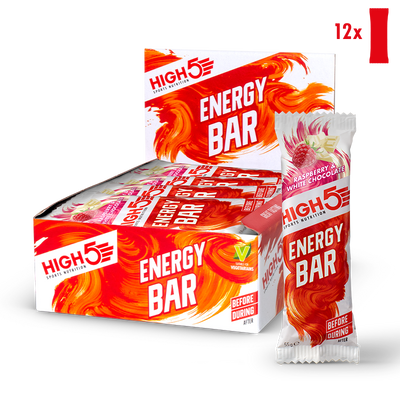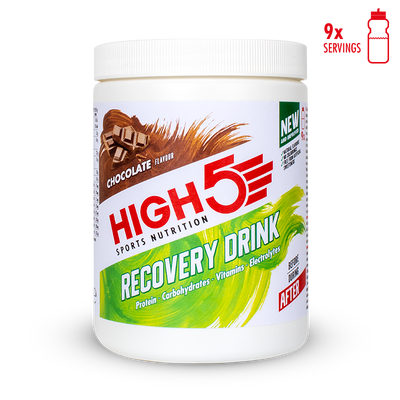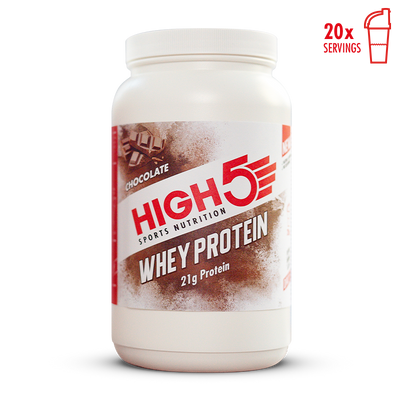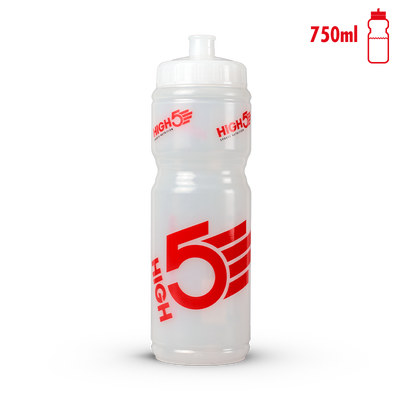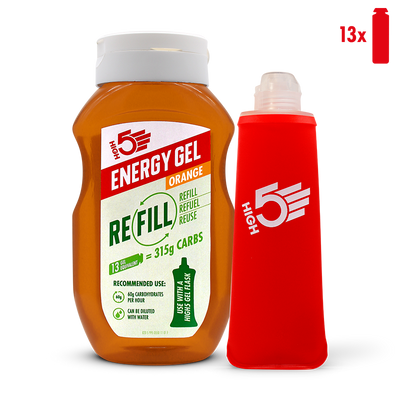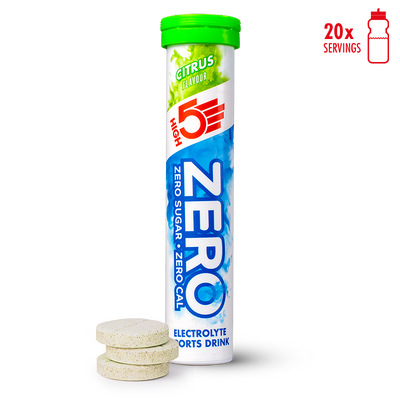Blood pumps through your veins as your heart races. Your muscles strain and ache, but still, you push on. Mile after mile, you revel in the thrill of the open road and the power in your stride. For you, running isn’t just exercise; it’s freedom and escape from normality.
If you can relate to this, then you already know the joy of going on a run — same with the other 621.6 million people that run around the world. But how do you take your running to the next level and become the best runner you can be? Learn how to be a better runner in this detailed guide put together for the athlete who wants more!
How to Be a Better Runner Summary
Improving as a runner requires focused training, smart nutrition, and the right gear. Here's a concise guide to boosting your running performance:
-
Right Running Shoes: Essential for injury prevention and optimal running form. Specialist stores can help find shoes that match your running style, ensuring support and efficiency.
-
Strength Training: Incorporating weight and bodyweight exercises 2-3 times a week enhances muscle endurance and refines running technique, crucial for effective running and weight management.
-
Varied Training: Mix hill sprints and high-intensity interval training (HIIT) into your routine. These workouts, performed at a moderate or fast pace, improve endurance and speed.
-
Nutrition and Hydration: Optimal performance is fueled by a diet rich in complex carbs and healthy fats. For race day energy and hydration, HIGH5 Energy Gels and Zero Hydration Tablets offer a convenient boost, replenishing essential electrolytes and carbs.
-
Recovery: Adequate rest, including tapering and quality sleep before an event, is vital. Engaging with a running group or a coach can also provide valuable insights and motivation.
Incorporating these strategies, along with using products like HIGH5 Energy Gels for sustained energy and Zero Hydration Tablets for electrolyte balance, can significantly improve your running performance and enjoyment.
How Can I Improve My Running? (Assessing Your Current Ability)
To improve your running and empower your legs to run fast despite fatigue, aim to increase the pace in the last minute of each mile in your long runs. If you’re running 12 to 14 miles, for example, run 10 miles at a relatively normal pace, then increase the speed to tempo level in the last 2 to 4 miles. That’s how to become a better runner via modified workout sessions.
We recommend following these 3 steps to improve your running:
- Start by timing yourself over a set distance to determine your pace.
- Next, consider your running style and how far you currently run each week.
- Finally, think about any limitations or weaknesses holding you back.
1. Start by timing yourself over a set distance to determine your pace.
For beginners, try running a mile as fast as you comfortably can; experienced runners should aim for 3–5 miles. Use a running app to track both your sustainable pace and time. This establishes your baseline so you can set appropriate goals to improve.
2. Next, consider your running style and how far you currently run each week.
If you only run once a week, adding an extra run or two can quickly boost your endurance and speed. Slowly increase your weekly mileage by no more than 10% each week to avoid injury. The more you run, the faster and stronger you’ll get — before you know it, you’ll be running 8 or 9 miles per session.
3. Finally, think about any limitations or weaknesses holding you back.
Maybe hills wipe you out, or your form needs work. Identify potential weaknesses and work towards eliminating them early so you can crush your goals.
With an honest assessment of your current ability, the proper tools to track your progress, tough training sessions, and a plan to strengthen your weaknesses, you’ll be well on your way to becoming a better runner in no time. The key is starting where you are and building up gradually.

How Can I Run Longer Without Getting Tired? (Setting Achievable Goals)
To run longer without getting tired, ensure to breathe in via your nostrils and breathe out slowly via your mouth. We recommend pairing breathing rhythms with jogging while making sure to drink enough water.
Also, if you’re curious about how to improve as a runner and go longer without getting tired, you need to start slow and build up your endurance. Don’t aim to double your mileage overnight; set small, achievable goals and increase them gradually.
Here are 3 valuable tips to help you run longer without experiencing fatigue:
- Start with what you can handle.
- Find your motivation.
- Refuel and rehydrate.
1. Start with what you can handle.
If you currently run 3 miles a few times a week, try increasing to 4 miles for your long run. Give your body time to adapt, then build up to 5 miles. Keep your pace easy and comfortable; there’s no need to sprint! Slowly ramping up your distance and speed is the key.
2. Find your motivation.
Whether you want to run a local 5K or train for a marathon, find what motivates you. Set a goal to work towards to keep you accountable. Tell friends and family about your goal so they can support you. Having motivation and support will help you push through those tough runs.
3. Refuel and rehydrate.
Staying properly fueled gives you the energy to run longer. Eat healthy, balanced meals with carbs, protein, and fat. Drink plenty of water to stay hydrated, and for longer runs, use electrolyte drink tablets like HIGH5 Zero to replenish the salts you lose through sweat. Suffice it to say, knowing what to eat before a run, having a post-run diet plan, and rehydrating when necessary are key to sustaining your endurance.
With the right motivation, gradual build-up, and nutrition—speaking of which, we recommend always keeping a HIGH5 Energy Gel handy—you’ll be running longer in no time. Start today and stick with it — your endurance and stamina will improve over the weeks and months to come!
What Exercise Makes You a Better Runner? (Improving Your Techniques)
One of the exercises that can make you a better runner is walking lunges. It can boost stride length, aiding faster runs. To do this exercise, stand with your feet shoulder-width apart. Then, take one big step forward with a leg and bring your rear knee and body in close proximity to the ground, ensuring there is no contact.
Here are 4 important exercises you can engage in:
- Strength training and stretching
- High-intensity interval training (HIIT)
- Hill training
- Plyometrics
Including strength and plyometric exercises in your daily routine improves your technique as well as solving issues like heavy legs. There are ways to overcome heavy legs to improve your running performance. Let's discuss the four exercises in detail.
1. Strength Training and Stretching
Build stronger legs and core to improve your power and endurance. Do bodyweight exercises like squats, lunges, calf raises, and planks. Use dumbbells or a barbell with a squat rack to make things more challenging. Stronger muscles will reduce injury risk and make running feel easier; stretching also improves your flexibility and range of motion. Aim for 2–3 strength sessions and stretch 3–4 times a week.
Incorporating strength training with home gym equipment into your weekly routine can significantly enhance your running performance, build muscle endurance, and reduce the risk of injury.
2. High-Intensity Interval Training (HIIT)
HIIT, where you alternate between short bursts of intense exercise and recovery periods, will boost your speed and stamina. After a good warm-up, sprint as fast as you can for 1 minute, then jog or walk for 2 minutes. Repeat this 10–15 times. Do HIIT 1–2 times a week in addition to your regular runs.
3. Hill Training
Running up hills works your legs differently and challenges your cardiovascular system. Find a hill that takes 1–2 minutes to run up, and after a good warm-up, run up as fast as you can, jog down, and repeat. Start with 5–10 hill repeats and build up as your fitness improves. Hill training once a week will make you a stronger runner.
4. Plyometrics
Plyometric exercises like box jumps, jump squats, and lunge jumps utilise the stretch-shortening cycle (SSC) of your muscles to generate power and speed. Start with 2–3 sessions a week of plyometric training, and be very careful to land softly and avoid overstriding. Also, plyometrics significantly increase injury risk, so build up volume and intensity slowly.

Here are 3 tips we recommend adhering to when engaging in plyometrics:
- Work on your form: Take quicker, shorter strides, land softly on the midfoot, swing your arms for momentum, and maintain an upright posture. Efficient form will make running feel effortless.
- Increase your mileage slowly: Aim for no more than a 10% increase in weekly mileage to avoid injury and burnout. Cross-train for extra conditioning.
- Get enough rest: A runner's training schedule should involve taking one or two days off from running each week to recover. Consider stretching, foam rolling, and strength training on your rest days. A lack of rest will limit your progress and lead to fatigue and poor performance, so it’s important to take some time off running.
With dedication and consistency, improving your techniques and exercises will transform you into a tireless, efficient runner. Stay motivated by joining free running groups, keep yourself hydrated with some nutritious High5 Electrolyte Drink Tablets, and keep pushing your limits to achieve your running goals!
How Can I Be a Good Runner? (Following a 5-Point Training Plan)
As a beginner, following a training plan is key to understanding how to be a good runner. A good plan provides guidance and structure to build up your mileage and speed over time in a safe way. Many free training plans are available online for various skill levels and race distances. For starters, we recommend finding a plan for beginner 5K or 10K runners.
Look for a plan that suits your current fitness level and allows you to increase your mileage by no more than 10% each week. This will reduce injury risk and burnout.
The plan should include a combination of the following:
- Easy Runs: Go at a comfortable, conversational pace. These make up the bulk of your plan and help build endurance.
- Interval or Hill Training: Short bursts of speed with recovery periods in between. This helps increase power and speed.
- Long Runs: 15–20% of your weekly mileage in one run. Builds endurance for racing and mental toughness.
- Strength Training: Do exercises like squats, lunges, and pushups 2–3 times a week. Stronger muscles will make you a better, more efficient runner.
- Rest Days: Take 1–2 days off from running each week. Rest is just as important as training for recovery and performance.
Following a plan also provides motivation and accountability. Use a journal to record your runs and track progress, celebrating small wins along the way for encouragement. Running with a partner, qualified running coach, or group can also help on those days you don’t feel like lacing up.
Most of all, start slow and build up gradually. Don’t increase your mileage or speed too quickly. Listen to your body, and don’t be afraid to repeat weeks or take extra rest days if needed. The key is consistency over the long run. Stick with your plan, and you’ll be zipping through 5Ks before you know it! With the right motivation and nutritional plan, you can become an excellent runner.
How Do I Go From Out of Shape to a Runner? (Cross-Training to Become Better)
To go from out of shape to a runner, engage in 2 to 3 short, easy runs weekly. Additionally, you may stick to a 5K training plan aimed at beginner runners and people who took a long break from running but picked it up once again. Another option is to adopt a strategy that pairs walking breaks with runs. That’s how to become a good runner and go from couch to 5K.
In summary, the key is starting slow and building up your speed workout endurance over time through cross-training running.
Here are 3 essential tips to consider:
- Start with walking.
- Add in short running intervals.
- Set small goals and reward yourself.
1. Start with walking.
If you’re currently inactive, walking is the perfect way to ease into an exercise routine. Aim for at least 30 minutes of walking most days of the week. This could be going for a stroll on your lunch break, walking the dog after work, or going on weekend hikes.
2. Add in short running intervals.
Once you’ve established a walking habit and built up your endurance, it’s time to start alternating between walking and jogging. Start with just 30–60 seconds of running at a time, and walk when you need to recover. For a few weeks, slowly increase your running intervals to 3–5 minutes at a time. The key is to not push yourself too hard as you’re just getting started. Listen to your body, and don’t overdo it.
3. Set small goals and reward yourself.
The key to staying motivated is setting small, achievable goals and rewarding yourself when you accomplish them. Start with running just 10–15 minutes a couple of times a week. Once that feels comfortable, aim for 20–30 minutes 3 times a week. Reward yourself after hitting each milestone to stay on track. Before you know it, you’ll be running 5Ks and beyond!
Sticking with your running plan and building up slowly is the key. Don’t get discouraged if you need extra walking breaks or can’t run as far as you’d like at first; every great runner starts somewhere. Keep putting one foot in front of the other and stay consistent, and soon, you’ll be well on your way to becoming an excellent runner.
Can Anyone Become a Good Runner? (Eating Right to Fuel Your Runs)
Yes, anyone can become a good runner. You mustn’t remain in shape or be athletic to become a runner; you only need the drive to get into your shoes and get out the door. Provided that you’re determined to take that first step, you can become a good runner regardless of whether you plan to shed some weight or show yourself that you can achieve anything you put your mind to.
Fueling your body properly will give you the energy to progress in your running program. Focus on lean proteins like fish, chicken, and beans, as well as high-quality carbohydrates from whole grains, fruits, and vegetables. Stay hydrated and energised with HIGH5 Energy Drink Powders, and consume healthy fats from nuts and avocados. At the same time, limit excess sugar, salt, and processed foods, which can sap your endurance.
Consider adding power-packed foods like sweet potatoes, bananas, and quinoa, which fuel your muscles and help with recovery. They’re rich in essential vitamins, minerals, and antioxidants. Additionally, maintain a regular meal schedule to ensure your body has a continuous energy supply. Don’t forget to replenish your body after your workouts with a balanced meal that includes protein for muscle repair and growth.
Remember, your diet is as important as your running regimen. A diet filled with a balance of proteins, carbohydrates, and healthy fats will keep your body in top running condition. So, strap on those running shoes, fill up on good food, and take that first step towards becoming a stronger runner.
Is It Possible to Get Better at Running? (Hydrating Properly for Optimal Performance)
Yes, it’s possible to get better at running. Interval training helps enhance running speed by slowly boosting the efficiency with which your body eliminates lactic acid from muscles. What this means is that, in the long run, you’ll be armed for faster, longer runs.

More importantly, knowing how to rehydrate fast is key to becoming a better runner and staying healthy. As an active runner, you’re bound to lose a significant amount of fluids through sweating, making hydration a critical part of your routine.
Beware of dehydration! Even a slight water loss of 2% of your body weight can negatively affect your stamina and make running more challenging. In extreme cases, dehydration symptoms can include dizziness, accelerated heartbeat, and even heat stroke.
Here are 6 recommended tips to ensure you stay adequately hydrated for optimum running performance:
- Make it a habit to consume ample water throughout the day, beyond just during your run: Aim to drink 35 mL of water per kg body weight each day. For instance, if you weigh 70 kg, your goal should be about 2.4 L or 10 cups of water daily.
- Hydrate with 450–700 mL (2–3 cups) of water 1–2 hours before running: This allows your body sufficient time to absorb the fluids.
- For longer runs exceeding an hour—e.g., lasting up to eight or nine hours—opt for an electrolyte drink tablet: This formula replenishes the sodium and potassium lost through sweat. Opt for a drink with less than 8% carbohydrates and over 200 milligrams of sodium per 240 mL serving.
- Listen to your body’s thirst signals: Don’t wait until you’re extremely thirsty to hydrate. Keep water accessible and take small sips every 15–20 minutes during your run.
- Weigh yourself before and after extended runs: Rehydrate with about 700 mL (3 cups) of fluid for every kg lost. It’s most effective to replenish fluids within 2 hours post-run.
- For ultra-long runs, consider utilising a hydration pack: Carrying enough water for runs lasting over 2 hours can be challenging. A hydration pack facilitates drinking on the move, ensuring you stay sufficiently fueled for top performance.
Committing to a proper hydration routine will transform you into a stronger, more efficient runner. Regularly consuming water and electrolyte drinks not only makes running feel smoother but also boosts your endurance and reduces health risks. The payoff of adequate hydration is profound, so keep your water bottle filled.
How Long Does It Take to Become a Better Runner?
Becoming a better runner is a journey, not a destination. The time it takes depends on several factors, including your physical and mental demands, current fitness level, running experience, and goals. The most important thing is not how long it takes but committing to continuous self-improvement.
Let’s see how long it takes to become a better runner, depending on your skill level.
Beginners
If you’re just getting started as a runner, don’t be discouraged if you can only run for a few minutes. Every run, no matter the duration, will make you stronger and build your endurance.
Start with only a brief contact run/walk interval program and slowly decrease the walking periods over weeks and months. Within 3–6 months of regular running, 3 times a week, you can work up to running 30 minutes continuously at an easy pace. This is a great milestone for a beginner!
Occasional Runners
Are you an occasional runner looking to step up your game or you took a break and are looking to get back into running?
Increase your weekly mileage by no more than 10% each week. For example, if you currently run 10 miles per week, bump that up to 11 miles next week. Continue this gradual progression, and in 2–3 months, you’ll be running significantly farther and faster. Strength training and stretching 2 times a week will further boost your performance.
Expert Runners
For competitive or long-distance runners, shaving seconds off your race time or completing your first marathon can take 6–18 months of diligent training. Work with a coach to develop a customised training plan, incorporate speed and hill workouts every training session, increase your long run distance, and make sure to schedule adequate rest days. Most importantly, staying focused on your goals will help you push through challenges.
Whatever your running level and goal, improving your speed and endurance requires motivation, consistency, and patience. But with each milestone you achieve, you’ll gain confidence and a sense of accomplishment that makes all the effort worthwhile. Keep putting one foot in front of the other — you’ll get there eventually, one run at a time.
Preventing and Treating Common Running Injuries
As a runner, injuries are unfortunately inevitable at some point. The repetitive impact of running takes a toll, but the good news is many common injuries can be prevented or treated at home. The key to becoming a better runner with minimal injury is listening to your body and not pushing through pain.
Here are 6 common running injuries, their causes, and corresponding quick fixes, plus prevention tips:
- Shin splints
- Plantar fasciitis
- IT band syndrome
- Blisters
- Achilles tendinitis
- Runner’s knee
1. Shin Splints
Otherwise referred to as medial tibial stress syndrome, shin splints cause pain along the shin bone. They’re often from overuse, increasing mileage too quickly, or worn-out shoes.
To prevent shin splints, build mileage slowly, stretch calves, and replace shoes every 300–500 miles. If you have shin splint pain, ice the area, take an over-the-counter anti-inflammatory, and avoid high-impact exercise for a week or two.
2. Plantar Fasciitis
The plantar fascia is the thick band of tissue that runs across the bottom of your foot and connects your heel bone to your toes. Plantar fasciitis is an inflammation of this tissue, causing sharp stabbing pain in the heel and arch of the foot.
To prevent this running injury, stretch your calves and feet, don’t walk barefoot, and use orthotic inserts if you have high arches. Treatment includes icing the heel, physical therapy exercises, and wearing a night splint. Anti-inflammatories can also help reduce pain.
3. IT Band Syndrome
The iliotibial or IT band runs down the side of your thigh, from your hip to just below your knee. IT band syndrome occurs following an inflammation or tightening of this band, triggering pain on the outside of the knee joint.
Foam rolling and stretching the IT band can help prevent and treat this issue. Apply ice, rest, and take an anti-inflammatory if needed. If pain persists, see a physical therapist for targeted exercises and deep tissue massage.
4. Blisters
Blisters are caused by friction, often from ill-fitting or wet shoes. Moisture-wicking socks, proper-fitting shoes, and keeping feet dry can help prevent blisters.
If you feel a blister forming, apply a hydrocortisone cream and cover it with a blister pad or bandage. Drain any large blisters with a sterile needle and keep them clean and covered. Smaller blisters often heal on their own, requiring less attention.
5. Achilles Tendinitis
The Achilles is the large tendon connecting your two major calf muscles to the back of your heel. Overuse or quick increases in distance or speed can trigger Achilles tendinitis, leading to a dull or sharp pain along the back of your tendon, especially during or after running.
Effective prevention strategies include incorporating strength training for your calves, gradually increasing your running distance, and wearing supportive shoes.
Recommendations for managing Achilles tendinitis include resting and icing the area. Stretching and strengthening exercises can also be beneficial. If pain persists, consider consulting a physical therapist.
6. Runner’s Knee
Runner’s knee, or patellofemoral pain syndrome, is a common injury characterised by pain around or behind the kneecap. It’s typically caused by the high impact of running, muscle imbalances, or malalignment of the kneecap. To prevent runner’s knee, focus on strengthening your hips and quadriceps, maintaining a healthy weight, and avoiding training on hard surfaces whenever possible. Should you experience symptoms, rest and ice the affected area, use a knee brace or supportive taping, and consider physical therapy for targeted exercises.
Remember, it’s crucial to pay attention to your body’s signals and not to ignore the pain. Properly addressing injuries and knowing when to rest can ensure you continue to enjoy running for many years to come. When in doubt, always seek medical advice, as some injuries may necessitate professional care for complete recovery. In a nutshell, understanding your body is a great stride towards becoming a better runner — it’ll provide the cues on when it’s fit to push ahead or when it needs time to recuperate.
Frequently Asked Questions
Is it possible to get better at running?
Yes, it’s possible to get better at running. Interval training helps enhance running speed by slowly boosting the efficiency with which your body eliminates lactic acid from muscles. What this means is that, in the long run, you’ll be armed for faster, longer runs.
Improving at running involves a combination of consistent training, proper nutrition, and adequate rest. Gradually increasing your running distance or pace, incorporating interval training and strength training can all contribute to improved running performance. It’s also important to fuel your body with the right nutrients and allow enough time for recovery to prevent injuries.
Remember, everyone progresses at their own pace, so patience and persistence are key. Always listen to your body and consider seeking advice from fitness professionals to ensure a safe and effective training plan.
How do I get better at running?
Here are 5 tips on how to get better at running:
- Prioritise consistency if you’re a new runner.
- Engage in hill repeats.
- Go on strides before attempting sprints.
- Don’t neglect cross-training.
- Incorporate speed play.
Remember to start preparing a week before the race if you’re running a marathon. If needed, seek expert advice from a running coach or join a local running club beforehand.
How many months does it take to become a good runner?
How long it takes for a runner to become good depends on many factors, including their current fitness level, training goals, and consistency. However, most runners can expect to see noticeable improvements in their cardiovascular fitness and muscle strength within 4–6 weeks of regular training. To reach their full potential, runners should continue to train consistently for several months or even a year.
How to be a fast runner in one day?
To become a fast runner in one day, we recommend practising interval running, as it’s proven effective in boosting stamina and speed among athletes. This exercise session typically involves running at a medium pace for 1 minute, followed by jogging for 2 minutes. Repeat this workout set 4 times, followed by a 5–10 minute cool down routine at a walking pace.
Will running reduce belly fat?
Several studies report that moderate-intensity jogging (short and long distances included) and high-intensity running (uphill running, variable running, HIIT paired with running, or sprinting) are highly effective. These exercises may be helpful in significantly reducing belly fat, especially when paired with a healthy diet.
Remember that spot fat reduction to shed weight in a particular body area isn’t effective/possible. Running is a great way to achieve generalised body weight reduction, belly fat inclusive. Aim to run at a moderate to high intensity for at least 30 minutes 3–5 times per week, and include interval training in your workouts for maximum fat burning.
Conclusion
You now know how to be a better runner. No more excuses — it’s time to get out there and just do it! Lace up those running shoes, step out your front door, and start moving.
Remember that every mile begins with a single step, so start small and build up your endurance over time. But most importantly, don’t forget to maintain an adequate supply of the best energy and hydration products to keep you going!



